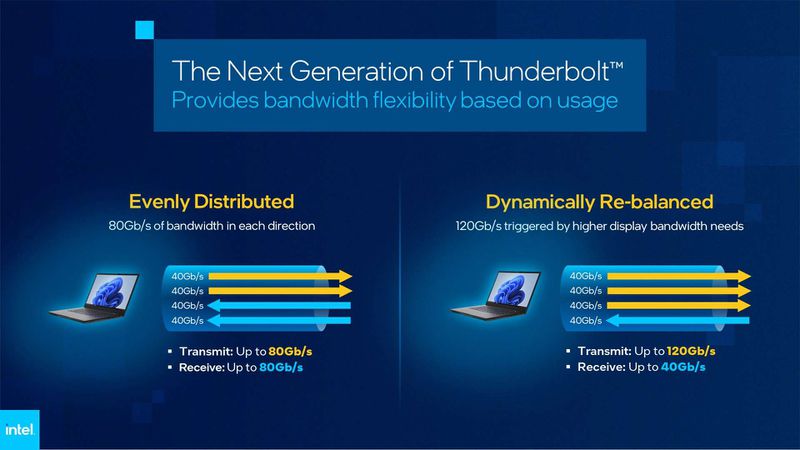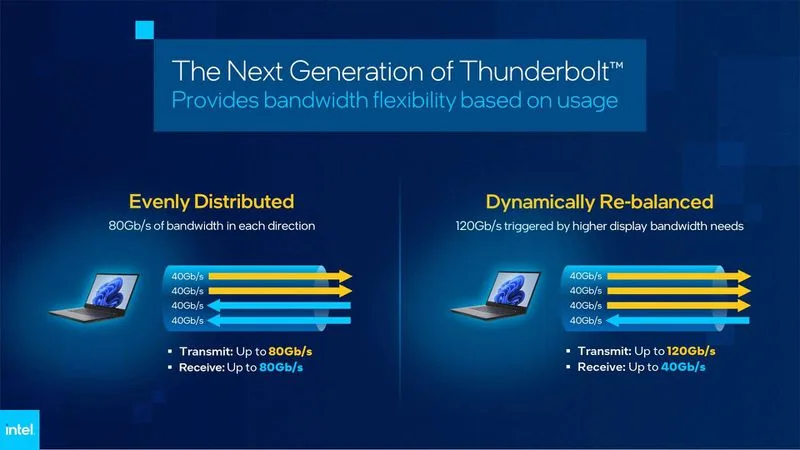Will that help 8K adoption? And what about HDMI?
There have been a number of significant developments in recent weeks in the world of display and, especially, monitor interfacing over recent weeks. It’s time for me to catch up.
First, in September, the USB Implementers Forum (USB-IF) said it was going to double the throughput of USB4, while using the same copper cables—no mean feat—but didn’t say how it was going to do it. Now it has revealed the key change that it is making and more about this important change. VESA, at around the same time, announced DisplayPort 2.1, which helps with the integration with USB4. Not to be outdone, Intel gave some clues about Thunderbolt 5, which will go the same way.
If that wasn’t enough, last week AMD announced its latest AIBs and GPUs, the RX 7900 series, and said it would support up to 8K 165 Hz or Ultra HD at up to 480 Hz using DisplayPort 2.1. In the video, Samsung teased a new 32:9 (we think) 7680 × 2160 resolution (we think) monitor that will be officially launched at CES, along with new 8K monitors from a number of makers. That’s a lot to digest, but it really moves things along, especially for 8K.
USB4
First, what magic has USB-IF conjured up from its existing copper cables to double the throughput? The key change in USB Version 2 is a move from two values per clock pulse (i.e., +1/-1 or 1/0) to three values (+1/0/-1), which allows you to send up to 8 values in every two clock cycles, instead of just 4. This is a form of pulse-amplitude modulation (PAM), and the specific scheme it uses is PAM-3, which is already used in some other interfaces including some Ethernet.

The use of this technology doubles the data that can be transmitted and can use the same copper as the first USB, although new transmitters and receivers will be needed, so products are not likely to be around until the end of 2023 or early 2024. My guess is that the big push will be at CES 2024. The technology means that the existing four lanes of communication are each doubled from 20Gbps to 40Gbps, which means that in bidirectional mode, the interface will support 80Gbps each way.
However, for displays, there is an additional mode, whereby three of the four lanes can be used for display output and one used for returning data. That will give 120Gbps one way and 40Gbps back—and that’s enough to support 8K 120p or dual 8K 60p displays even without any DisplayStream Compression (DSC) and with 4:4:4 graphics data.
USB has also developed a standard for active cables, but that’s a topic for another day.
DisplayPort 2.1
VESA is also updating DisplayPort to v2.1 to tighten it up to work better with USB Type-C and USB4, and it will now use the same physical interface as USB4. It will also mandate the use of DSC as well as the Panel Replay specification (which allows the display to keep a frame store and only sends the changing pixels over the interface). That’s a big deal for multiple displays, high-resolution, and high-refresh systems.
Mandating DSC support is a big deal in helping to deliver higher resolutions and frame rates, in my view. Although, in general, compression schemes, including this one, are “lossy.” I have seen enough demos of DSC to be convinced that you really cannot see any artifacts and that DSC is genuinely “visually lossless.”
Thunderbolt 5
Intel has also said that it will, of course, update Thunderbolt to version 5. Details have not been made public, yet, but the company has said Thunderbolt 5 will support the bidirectional 80Gbps and the optional 120Gbps/40Gbps scheme. That will allow host systems (such as forthcoming Apple Macs, which are expected to have Thunderbolt 5 support) to support multiple 8K displays.

AMD ups the ante for gaming displays
AMD launched its RX 7900 GPUs and cards, and really emphasized its support for DisplayPort 2.1, which will support up to 900 Hz in 1440p, 480 Hz in Ultra HD, and 120 Hz in 8K. New monitors that will support DisplayPort 2.1 will be available from Dell, Samsung, Asus, LG, and Acer, AMD said. Performance depends on the game as well, but AMD said Assassin’s Creed Valhalla Dawn of Ragnarok will run at 96 fps in 8K.

All of this news gives a big boost to the possibility for 8K in the PC space and, presumably, later in the console arena. I’m among those who think that higher frame rates are even more important in 8K than in lower resolutions and that widespread support for 120 Hz is really going to be a significant change for the future.
This announcement also got me thinking, what about HDMI? I remember years ago, the USB-IF, in one of my regular CES meetings, telling me that USB had the aim of being the “only interface for everything.” It seems to me that USB is getting a long way towards this with mandating USB Type-C on any volume smartphones (thanks, EU), the development of USB PD to power devices, and now with this high-end display support. (Paul Gray, research director at Omdia, recently pointed out to me that almost all the power sockets in the upper floors of most houses could be replaced with USB ports with 240 W of PD—he was not wrong!)
Of course, there is a huge installed base of HDMI, but the idea of replacing HDMI with USB doesn’t seem crazy to me.
This article was first published on JPR’s Display Daily.






